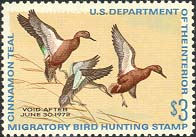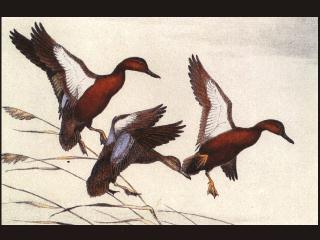

Back to RW38 Back to the Federal Index Home
A LITTLE HISTORY ON THE 38TH (1971-72) DUCK STAMP ARTIST


Mr. Reece broke his own outstanding record in the annals of the Duck Stamp competition when his design was selected as the best in the contest for the fifth time. No other man in the history of the competition has a record so outstanding- a record that truly represents the respect he has gained for the wildlife are he has been producing for so long. With the respect, comes curiosity as to what makes this unusual and talented man tick.
There is little information in a straight biography that gives us a clue. Mr. Reece was the son of a Quaker minister, and it is not surprising to find out that he leads a calm life. It is a lifestyle filled with hard work and quiet pleasures. Mr. Reece gains his special feeling for wildlife from a background that he had in common with almost all wildlife artists. As with many of the well-known wildlife artists of the country, Mr. Reece's interests and abilities spring from a childhood of country living.
Of course, his natural talent has been developed by years of study. Over the years, the subjects he has studied have included biology, botany, taxidermy, anatomy of wildlife, and related natural sciences. This careful training has assured his reputation for accuracy, even among sportsmen, who are known to be an intensely observant breed themselves.
But even with his scientific training, Mr. Reece knows that the rapport with nature is a delicate web of impressions and philosophy, which constantly needs to be renewed. In a city, this rapport weakens. But a successful artist must also be a businessman, and there is a family to consider. Mr. Reece is well aware that it is difficult to be a Thoreau these days. Consequently, he has neatly resolved the dilemma by dividing his life into two parts. During the winter, he lives in a beautiful home in Des Moines and during the summer, he spends his time on 31 wooded acres beside a small lake in northern Minnesota. He does take longer trips at various times of the year, but in general, Mr. Reece feels that home is the Midwest, which he says, "is never very far from anywhere."
Mr. Reece hopes that the city/country combination will provide him with the right environment in which to pursue his new goal of higher quality in his paintings.
--------------------THE ART--------------------
Cinnamon Teal was painted in full color wash. The print was hand pulled from a lithograph stone using black and light tan ink. The prints were individually hand colored by Maynard Reece, his wife June, and his sons, Mark and Brad. Each print was numbered and signed in pencil. Only one edition of 950 prints has been printed to this date. This was Maynard’s fifth design win. The image size of the print is 6-3/8" x 9-1/4". The hand colorer for each print has signed his or her initials in the lower right hand corner of each print.
--------------------THE STAMP--------------------
Cinnamon Teal…Engraved by the Federal Bureau of Engraving from the original artwork. Printed in yellow, brown, green, blue, and black ink. The stamp sold for three dollars. Postal records show 2,426,058 stamps sold. First day of sale was July 1, 1971.
Most of the information contained above is from the book Federal Duck Stamp Story, Fifty Years of Excellence, by Laurence F. Jonson; Alexander & Co. It is used here with permission from the author. For more information on this book, please click here.